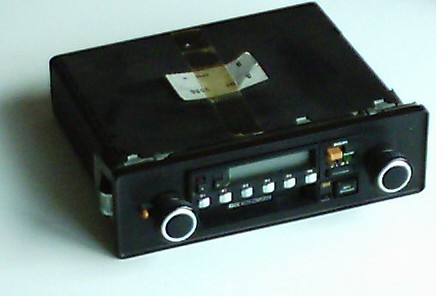
The UK quattro Network
The UK's mobile Audi 5-cylinder mechanic - 07833 654800, 24x7
Specialist in turbos, quattros, electrics and non-starts

The MCC is the radio that should have been fitted to the ur-quattro. It was designed specifically to reduce the requirement for driver intervention. Although it was originally intended for German geography and VHF radio systems, it actually worked very well in the UK because the BBC uses a similar frequency repetition system to German local radio. The 994 pictured above is the German model with a yellow ARI button - a similar model without this button (but still with all the circuitry) was available on the UK market. There were also three-component versions with separate tape deck and fader units and a later model with support for Dolby B and C noise reduction.
The UK car buying public regarded the "Dutch" Philips brand as inferior to Blaupunkt, even though the MCC was actually designed at Munich University and built in Wetzlar - never going anywhere near Holland. But at DM1400 in 1981 (£450) it was more than twice the price of the Blaupunkt Toronto SQR 44 - perhaps that was the problem.
What was special? The MCC didn't have "station" buttons - it had "programme" buttons. In fact, it had seventy (70) station memories and programming it was a little tedious, though it only had to be done once. Memory retention is guaranteed for ten years, even with the battery disconnected. The documentation pack delivered with the radio contained VHF/FM coverage maps for nine countries, with more available on request.
How did it work? The German radio broadcasting network abandoned long and medium wave in favour of VHF/FM years ago. But Germany is a hilly country and very many repeater stations are required. In fact, there are several hundred. The trick is that a relatively small set of frequencies are reused by stations that cannot interfere with one another. The BBC does the same in the UK, e.g., using the same frequencies for Radio 4 in Brighton, Yorkshire and Cornwall. The MCC exploits this - each of the chrome front panel buttons selects a set of ten frequencies stored under it. Radio 1 never uses a frequency that is used elsewhere by Radio 4, and only uses eight across the whole of the UK. So it's easy - put all of the Radio 1 frequencies under button P1, and so on for the others.
The MCC (it stands for "micro-computer controlled") uses an 8084 microprocessor to drive two completely separate radio receivers. Using the first, it scans the ten frequencies stored under the button that has been pressed to find the strongest signal and connects it to the IF circuits of the radio. Then it uses the second RF circuit to scan the other nine frequencies. If it finds one that is consistently stronger (or has a better stereo separation signal) it will swap them over and start scanning again with the first. The only indication that this has happened is a brief flash of the new frequency on the display.
Ten years before radio stations started adding identification signals, it was possible to drive from Dover to Edinburgh listening to Radio n without having to touch the radio.
There are some other interesting features. The economy of the front panel is misleading - and not just for thieves, who once ignored an MCC while stripping a line of cars of cheap rubbish with lots of flashy buttons. The Memolock button on the right gives access not only to medium and long wave bands (for the cricket, of course) but also to the 49m shortwave band. The cassette player adapts automatically to all tape types, including metal. The tuning knob tunes, but if it's flicked quickly it will jump across the band and if it's pressed it starts autoscan - even on the short waveband. The cassette eject button is also the fast forward button. There's a remote control for frequency selection and even a remote display for fitting the radio in the dashboard of chauffeur-driven cars.
In short, it's a radio that delivers perfect service without the driver continually having to mess with it - it's a "keep your eyes on the road and your hands on the wheel" radio and it should have been fitted to the ur-quattro as standard.